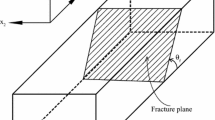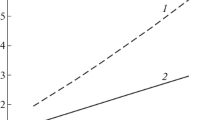Abstract
This paper describes a preliminary examination of the effect of in-plane constraint on creep crack growth under widespread creep conditions using the Q stress. Plane strain is assumed. Damage models for fracture of the process zone based on both ductility exhaustion and stress rupture are shown to predict a variation of the crack growth rate with Q. Lower levels of constraint lead to lower crack growth rates for a given C*. The results are used to outline a high temperature failure assessment diagram approach to constraint-dependent creep crack growth.
Similar content being viewed by others
References
Ainsworth, R.A. (1982). Some observations on creep crack growth. International Journal of Fracture 20, 147–159.
Ainsworth, R.A. (1993). The use of a failure assessment diagram for initiation and propagation of defects at high temperature. Fatigue and Fracture of Engineering Materials and Structures 16, 1091–1108.
Ainsworth, R.A. (1995). (editor), Assessment Procedure for the High Temperature Response of Structures. Procedure R5, Issue 2, Nuclear Electric Ltd, Gloucester.
Ainsworth, R.A. and O'Dowd, N.P. (1995). Constraint in the failure assessment diagram approach for fracture assessment. ASME Journal of Pressure Vessel Technology 117, 260–267.
Cocks, A.C.F. and Ashby, M.F. (1980). Intergranular fracture during power-law creep under multiaxial stresses. Metal Science 14, 395–402.
Goodall, I.W. and Ainsworth, R.A. (1977). Failure of structures by creep. Third international conference on pressure vessel technology, Tokyo. ASME II, 871–885.
Hayhurst, D.R. (1972). Creep rupture under multi-axial states of stress. Journal of the Mechanics and Physics of Solids 20, 381–390.
Kachanov, L.M. (1986). Introduction to Continuum Damage Mechanics. Martinus Nijhoff, Boston.
Milne, I., Ainsworth, R.A., Dowling, A.R. and Stewart, A.T. (1988). Assessment of the integrity of structures containing defects. International Journal of Pressure Vessels and Piping 32, 3–104.
Nikbin, K.M., Smith, D.J. and Webster, G.A. (1986). An engineering approach to the prediction of creep crack growth. ASME Journal Engineering Material Technology 108, 186–191.
Penny, R.K. and Marriott, D.L. (1995). Design for Creep. Second edition, Chapman and Hall, London.
Rice, J.R. and Tracey, D.M. (1969). On ductile enlargement of voids in triaxial stress fields. Journal of the Mechanics and Physics of Solids 17, 201–217.
Sanderson, D.J., Sherry, A.H. and O'Dowd, N.P. (1996). Compendium of β solutions for use within the R6 constraint modified framework. Report AEA TSD 0981, AEA Technology plc, Risley.
Shih, C.F., O'Dowd, N.P. and Kirk, M.T. (1993). A framework for quantifying crack tip constraint. Constraint Effects in Fracture (Edited by E.M. Hackett, K.H. Schwalbe and R.H. Dodds), American Society for Testing and Materials, Philadelphia, 2–20.
Symington, M., Shih, C.F. and Ortiz, M. (1988). Tables of plane strain mixed-mode plastic crack tip fields. Report MRG/DMR-8714665/1, Brown University, Providence.
Webster, G.A. and Ainsworth, R.A. (1994). High Temperature Component Life Assessment. Chapman and Hall, London.
Author information
Authors and Affiliations
Rights and permissions
About this article
Cite this article
Budden, P.J., Ainsworth, R.A. The effect of constraint on creep fracture assessments. International Journal of Fracture 97, 237–247 (1999). https://doi.org/10.1023/A:1018305919622
Issue Date:
DOI: https://doi.org/10.1023/A:1018305919622




